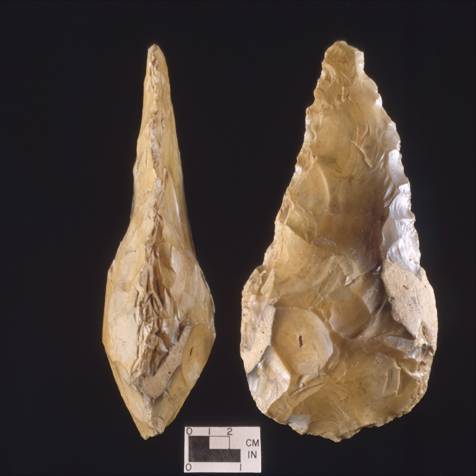 At Zhoukoudan in China over 100,000
artifacts were found in association with Homo erectus individuals.
Early (460,000-420,000 y.a.) tools were large and made of soft sandstone;
later (300,000-230,000 y.a.) smaller tools were made of fine quartz
and flint. Common tools were choppers, scrapers, point bunns, and
awls made from reformed flakes. Bone and horns were also used to create
tools. There is evidence of deliberate sculpting of dear skulls into
a bowl shape, most likely for drinking.
At Zhoukoudan in China over 100,000
artifacts were found in association with Homo erectus individuals.
Early (460,000-420,000 y.a.) tools were large and made of soft sandstone;
later (300,000-230,000 y.a.) smaller tools were made of fine quartz
and flint. Common tools were choppers, scrapers, point bunns, and
awls made from reformed flakes. Bone and horns were also used to create
tools. There is evidence of deliberate sculpting of dear skulls into
a bowl shape, most likely for drinking.
In Africa and in Western Europe a new tool technology developed, the Acheulian. These tools were made by working the core rock on both sides to produce sharper edges. Wood and bone were also used to refine the edges of the tools. This technology was used for over a million years. The tools were used for cutting, scraping, pounding, and digging. The main look of the tool was that of a hand axe. These tools were never found in Asia.
Homo erectus were hunters, gatherers, and scavengers. They ate deer, horse, fruit, berries, and ostrich eggs. For permanent shelter they lived in caves in small groups. Layers of ash at the Zhoukoudain cave over 18 feet deep suggest the use of controlled fire in hearths, used for cooking and warmth. It is unknown if Homo erectus wore clothing since this organic material is unperceivable. It is thought that they would have worn some type of animal skins to protect them from the harsh winters. From comparison of all specimens found the life span was only until 50 years of age.